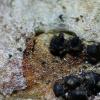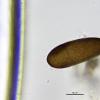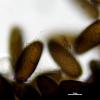
18-12-2025 21:17
Pol DebaenstThe identification took me to Byssonectria deformi

15-12-2025 07:09
 Danny Newman
Danny Newman
indet. Rutstroemiaceae sp. on unk. fallen leavesMc

19-12-2025 10:10
Patrice TANCHAUDBonjour, récolte réalisée en milieu dunaire, a

18-12-2025 17:23
 Bruno Coué
Bruno Coué
Bonjour,je serais heureux d'avoir votre avis sur c

18-12-2025 18:07
Margot en Geert VullingsThese plumes were found on rotten wood.They strong

17-12-2025 18:35
 Michel Hairaud
Michel Hairaud
Bonjour à tous/Hi to everyone I am passing along

15-12-2025 15:48
 Danny Newman
Danny Newman
Melanospora cf. lagenaria on old, rotting, fallen

15-12-2025 15:54
 Johan Boonefaes
Johan Boonefaes
Unknown anamorph found on the ground in coastal sa

15-12-2025 21:11
 Hardware Tony
Hardware Tony
Small clavate hairs, negative croziers and IKI bb
Pyreno on Pinus
Juuso Äikäs,
23-03-2025 01:00
These little black pyrenos were growing on bark of a fallen Pinus sylvestris branch. Some of the perithecia were more or less round, and some had a little neck.
These appeared to be rather old fruitbodies, but there were spores inside. Some had a septum, which was located either centrally or inequilaterally. The spore surface has some minute ornamentation, and the size of the spores is quite large: 34.5 - 38.5 × 12.9 - 15.6 µm, Q = 2.2 - 2.7; avg = 35.8 × 14.4 µm, Qav = 2.5; n = 5.
Any thoughts about the species/genus/family?
Mathias Hass,
23-03-2025 06:37

Re : Pyreno on Pinus
Hi Juuso
Looks very much like Diplodia sapinea, pycnidia with conidia. This fungus is very common on Pinus cones, needles, twigs and bark. May occasionally also be found on other coniferous trees, at least as D. sapinea s.l.
Kind regards
Mathias
Juuso Äikäs,
23-03-2025 06:57
Re : Pyreno on Pinus
Thank you Mathias. Yes, that does seem to fit. Apparently this species has just recently begun spreading here.



